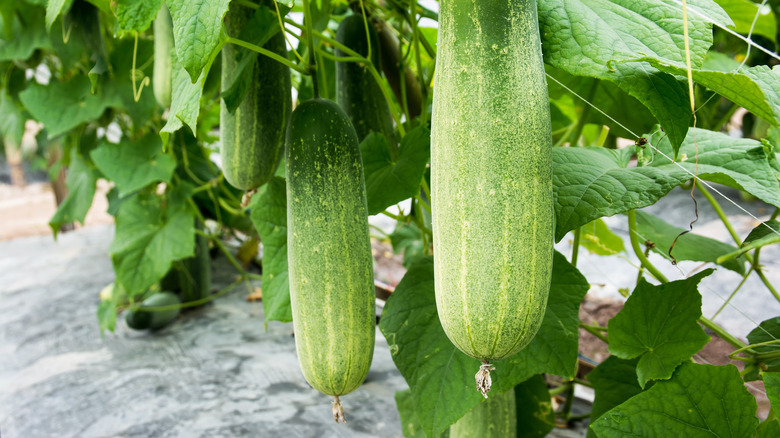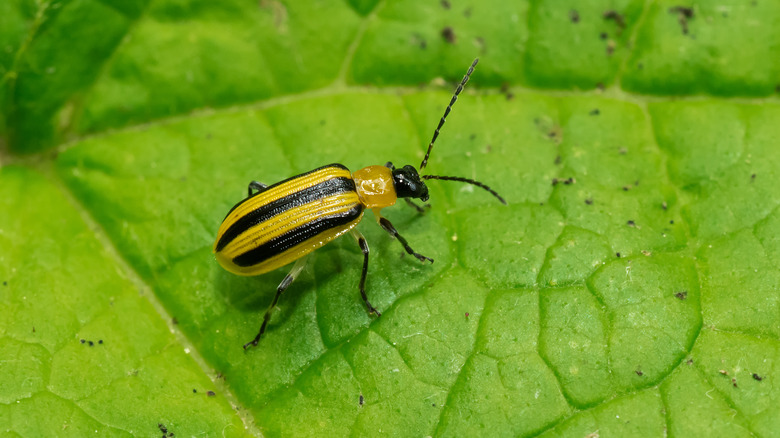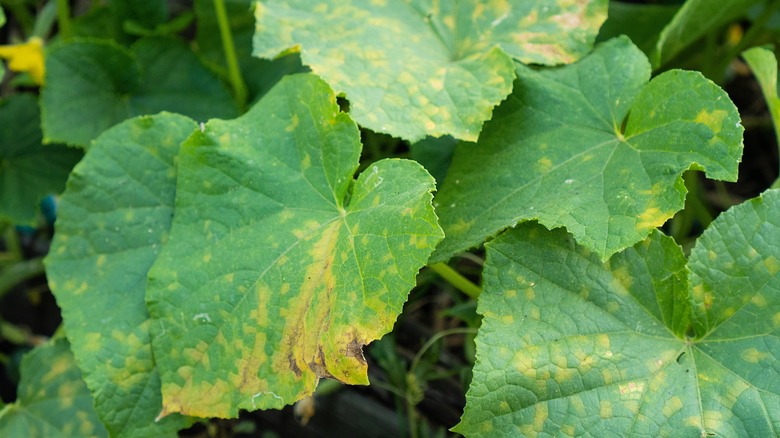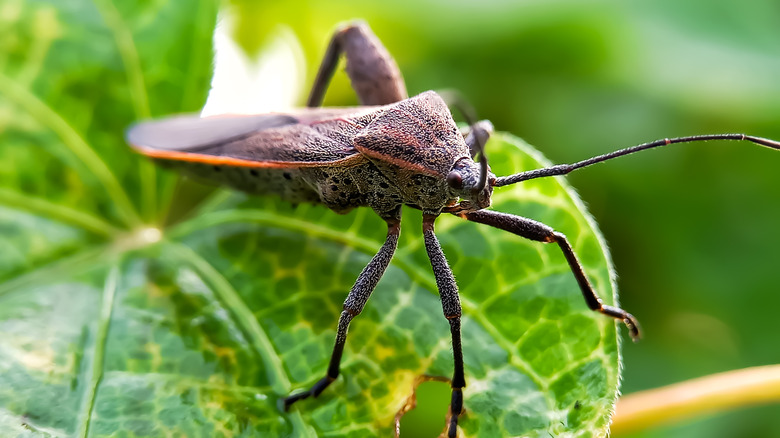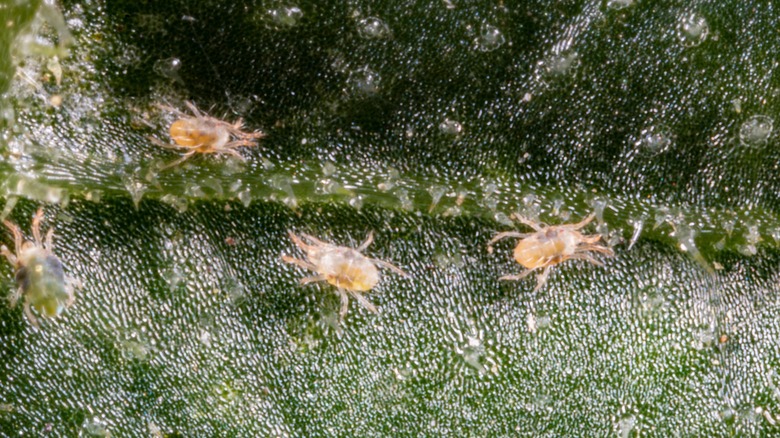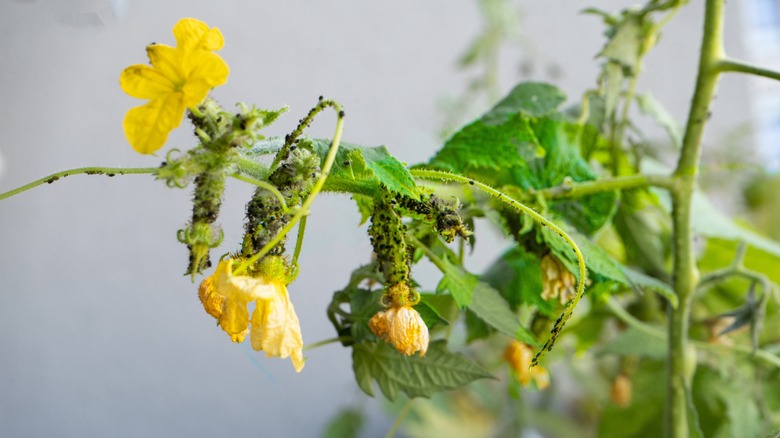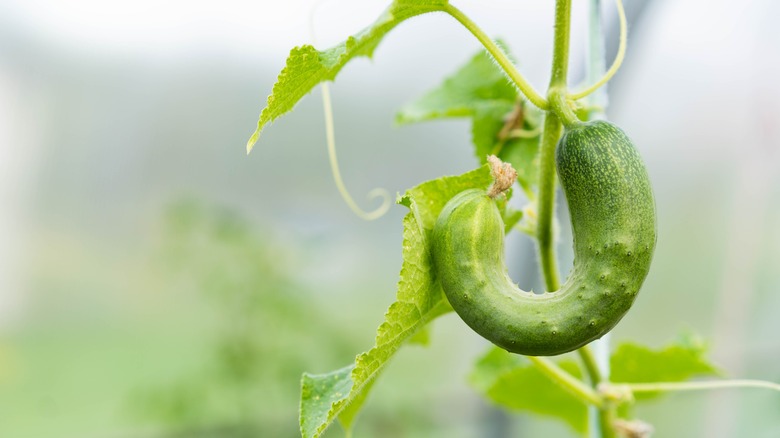6 Issues To Know About Before Growing Cucumbers In Your Garden
If you and your family enjoy eating sliced cucumbers or pickles on regular basis, these may be good reasons to consider growing cucumber plants in your garden. These are generally considered fairly easy to grow, with Lemon, Bush Crop, Boston Pickling, and Burpless Bush Hybrid among some of the more popular varieties.
Cucumber plants require careful fertilizing, watering, and temperature control in order to thrive and stay at their healthiest. Yet, as many beginners find, gardeners are not the only ones who appreciate cucumbers. These plants are targeted by a variety of different pests, and they can also be prone to certain diseases and other issues that can cause problems throughout the growth and harvesting processes. Aside from common mistakes everyone makes when planting cucumbers, it's important to be aware of some of these issues so you can tackle them right away before they ruin your cucumbers.
Cucumber beetles can cause damage throughout cucumber plants
One of the most common problems that can develop when trying to grow cucumber plants is for your hard work to essentially be undone by aptly named cucumber beetles. Of all the varieties, striped cucumber beetles may be the most dangerous. These small insects are only ⅕-inch long, but they can do a lot of damage to both the fruit and foliage of cucumber and other related plants, such as squash and melons. You can identify these pests due to their yellow color and three black stripes. Spotted cucumber beetles are about the same size, but they have yellow with black spots instead. Both types can damage cucumber plants. Unlike spotted cucumber beetles, striped varieties are also likely to lay eggs in these plants, and they can transmit bacteria that can cause your cucumber plants to wilt.
Before you resort to chemical pest control, there are ways you can keep cucumber beetles out of your garden to help prevent them from destroying your plants. Adding mulch around the cucumber plants and removing debris can help discourage these destructive beetles from laying eggs and taking shelter. Row covers may also help protect young cucumber plants by acting as a barrier against the beetles, but these will need to be removed once the plants begin flowering. Pesticides are only recommended as a last resort.
Cucumber plants are prone to viral, fungal, and bacterial diseases
Striped cucumber beetles can spread bacterial wilt to cucumber plants, but these are not the only damaging diseases that can occur. In fact, cucumber plants are particularly prone to a variety of fungal, viral, and bacterial diseases. Some of the most common include downy mildew, powdery mildew, cucumber mosaic virus, and bacterial-induced wilt. If you see signs such as wilting, discolored splotches on leaves, or fuzzy gray areas, you may be dealing with one or more of these issues in your cucumber plants.
Having a diseased cucumber plant can be disheartening, but there are ways you can help. First, if you see any early signs of disease, such as downy mildew on cucumbers, remove the affected leaves and stems immediately. Another way to prevent this is to choose a hardier variety of cucumber plants that are resistant to disease. There are several options for both pickle and slicer varieties to consider, and you may need to plant some of these on a trial-and-error basis to see which works best in your garden and geographical region. If you're starting cucumbers from seeds, check the package to make sure that the produce is certified as disease-free. It is also important to avoid planting cucumbers too close together, which prevents their leaves from drying properly after rain. Yet another option is to plant cucumbers throughout the season, rather than all at once.
Squash bugs can feast on cucumber leaves
While perhaps best known for feeding on squash and pumpkin plants, squash bugs can also present cucumber growers with major problems with their plants. In fact, these brownish-black colored insects are notorious for eating sap from plants, as well as interrupting the flow of nutrients from soil and water. For these reasons, young cucumber plants are more vulnerable to squash bug damage than their mature siblings.
Due to their potential destruction, getting squash bugs out of your garden is extremely important as soon as you find any of these insects roaming around your plants. Due to their larger size, it's possible to try various trapping and removal methods. If there are just a few squash bugs, you can remove them by hand and place them in soapy water. Another method involves laying out pieces of board they may hide in overnight, which you can then dispose of the next morning. You may also consider planting a few Blue Hubbard squash plants as a means to attract the bugs, so then they might leave your cucumbers alone. While not entirely foolproof, having a few of these "trap plants" on hand may help you control the squash bug population more generally.
Spider mites can target cucumbers during hot, dry weather
Spider mites are extremely small insects that cause very big problems for cucumbers. While difficult to see with the naked eye, you may know you have a spider mite problem if you see spotted and faded leaves, as well as fine webs underneath them. Also, spider mites can prevent photosynthesis necessary for plant health and growth. It's important to spot signs of spider mites as early as possible, especially during very hot and dry weather. Spider mite populations can explode in these conditions, possibly multiplying 70 times in just one week.
The good news is that you do have some options to get rid of spider mites on your cucumber plants. As soon as you see possible signs of them, you may consider an insecticidal soap followed by plenty of water. Frequently watering your cucumber plants can also help deter spider mites by keeping the plants cool and wet, conditions that these mites do not thrive in. Be sure to spray the undersides of leaves with a hose, as this can naturally help remove spider mites, too. If you do have a badly infested cucumber plant, you should promptly remove it to help prevent any remaining plants from getting infested.
Aphids are another common problems in cucumbers
Aphids are other types of insects that can cause problems in cucumber plants. Unlike other types of bugs that may attack plants during earlier growth stages, aphids tend to target cucumbers once the plants have grown runners. You might see these small tear-shaped bugs around different parts of the plant, and these can range in a variety of colors, including gray-white, blue, green, orange, red, yellow, and black. You're also most likely to spot them on the undersides of plant leaves, as well as on the fruit. If you don't see aphids at first, some other tall-tale signs include curled, discolored leaves.
Monitoring the leaves of your cucumber plants is the first step to help keep these potential disease-spreading insects in check. When you're actively trying to get rid of aphids, you can also interfere with their ability to take over your plants by spraying them with water. Insecticidal soap can help get rid of an active aphid infestation, but be sure not to use this product when temperatures are above 85 degrees Fahrenheit, so it doesn't evaporate off the plant. Another consideration is to try to plant cucumbers upwind, if possible, as this may discourage aphid migration.
Poor pollination can cause deformed cucumbers
Sometimes, even the most carefully nurtured cucumber plants end up producing deformed fruit. This can come as a shock if you don't have issues with insects and if your cucumber plants don't show any signs of diseases. The big culprit behind deformed cucumbers isn't related to disease or bugs, though—instead, the cause is problems with pollination. During cucumber pollination, honeybees and other types of pollinator insects naturally move pollen from the plant's male flowers to its female ones. Disruptions in the process can produce unusual-looking cucumbers, or those that fall off the plant prematurely. You may also end up with fruit that is uneven, misshapen, or smaller than normal. Insufficient pollination also affects other types of fruit in the Cucurbitaceae family, such as watermelon and squash.
While you can't make a pollinating insect come to your cucumber plants, you can do everything possible to help encourage the process to ensure healthy fruit. This includes providing adequate water while also ensuring cucumber plants don't become overheated. Using fertilizer can help the pollination process, but over-fertilizing can adversely affect cucumbers, too. Also, bees are less likely to approach plants that have been sprayed with commercial pesticides.
